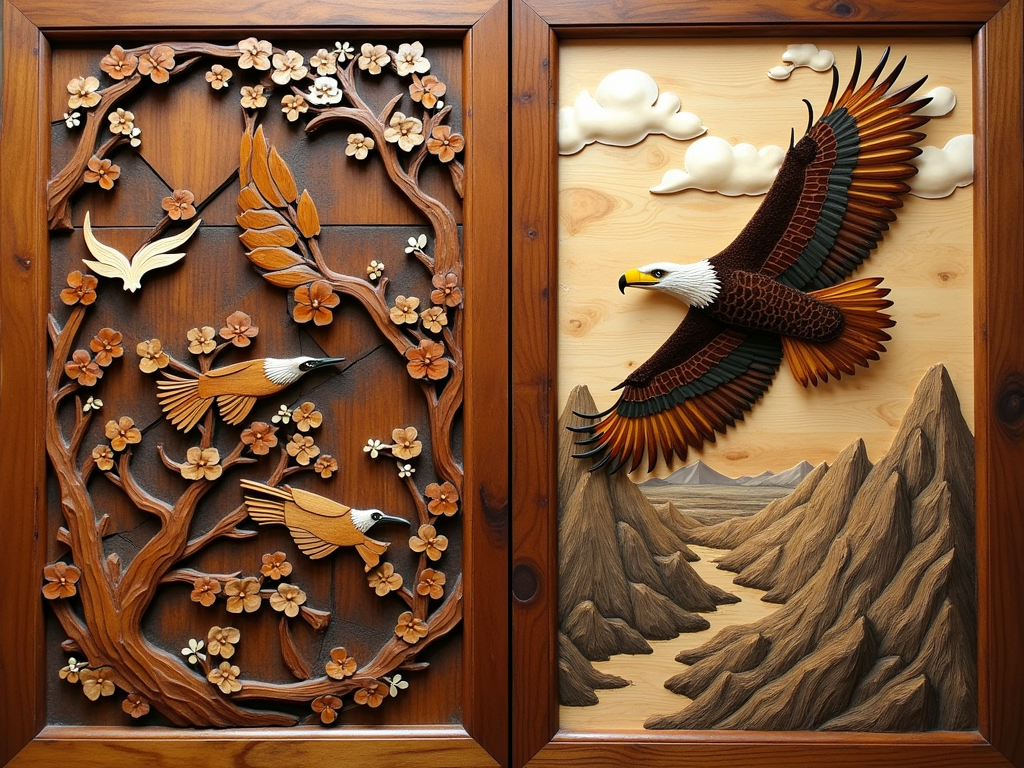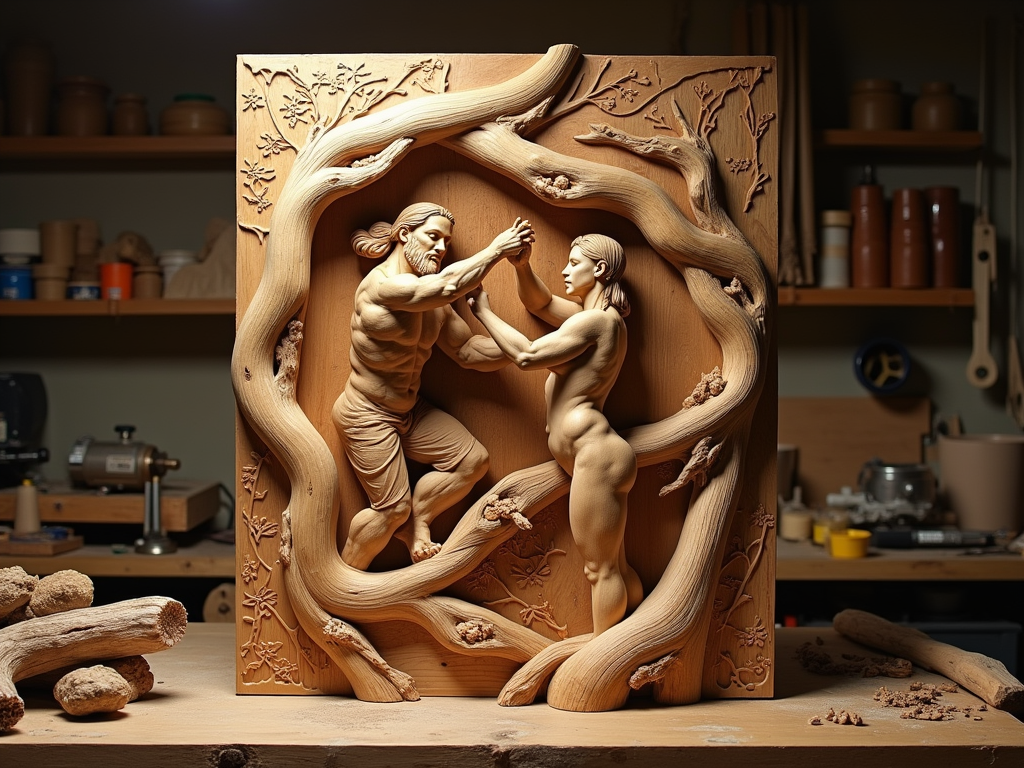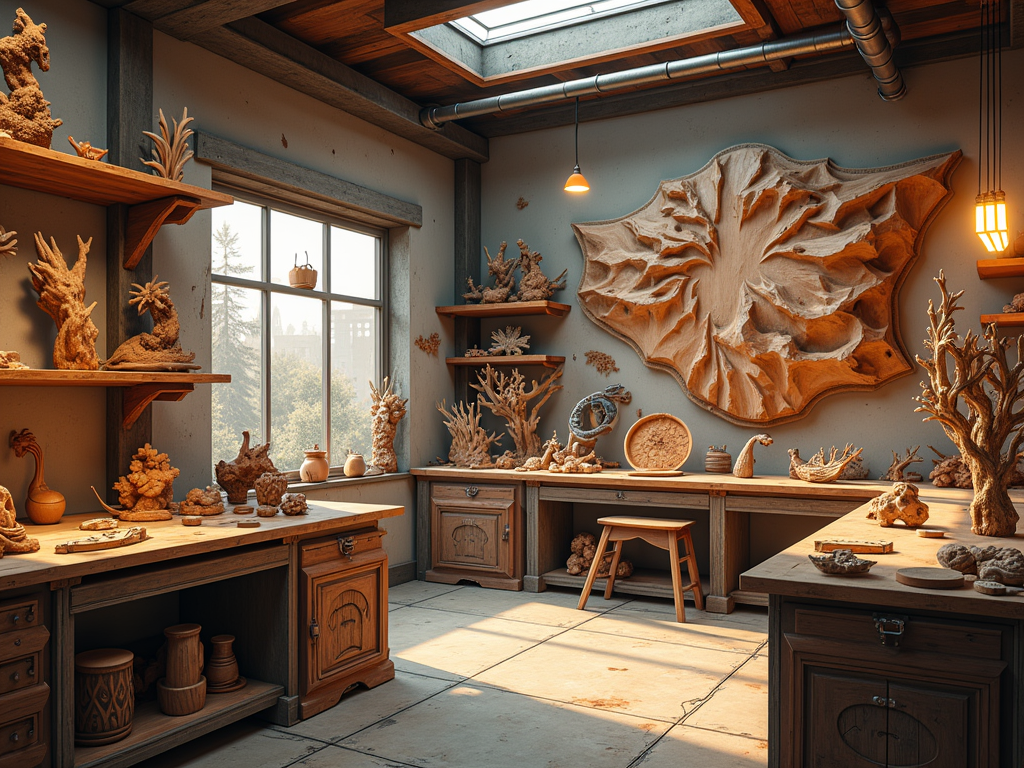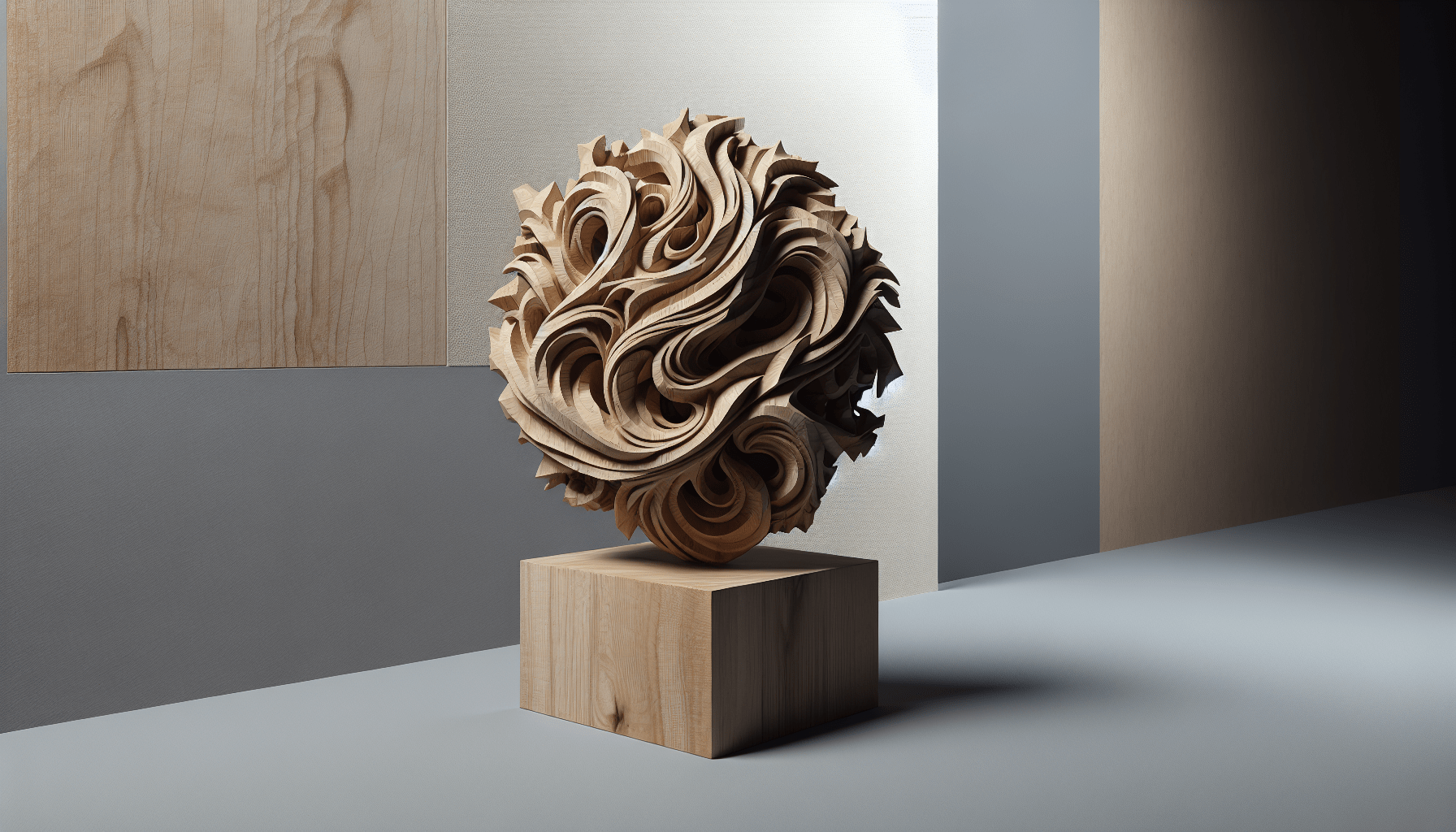Wood Art: Blending Classic Techniques with Modern Methods
Wood art combines classic techniques with modern methods to create stunning pieces. From hand-carved designs to machine-cut patterns, artists transform raw wood into beautiful works that captivate and inspire.
Key Takeaways
- Traditional techniques: Relief carving, whittling, and woodturning are used to create both functional and decorative pieces.
- Specialized forms: Techniques like marquetry and intarsia involve precise wood fitting to create detailed surface designs and three-dimensional pictures.
- Pyrography: Controlled wood burning offers unique artistic possibilities, creating detailed images and intricate patterns.
- Modern innovations: Digital technology, including CNC machines and laser cutting, enhances traditional craftsmanship with precision and efficiency.
- Mixed media: Wood is increasingly combined with materials like metal, glass, and resin for contemporary artistic expression.
Blending Traditional and Modern Techniques
I celebrate both time-tested methods and cutting-edge technologies in my work. Relief carving demands patience and skill, while digital tools add precision and repeatability. My pyrography creates subtle shading and bold patterns through careful heat control. Each project presents fresh opportunities to merge old and new techniques.
Exploring Mixed Media in Wood Art
Mixed media pieces allow me to push creative boundaries. Adding metal accents highlights the natural wood grain patterns. Glass inserts introduce depth and visual interest. Resin fills enhance natural features while also protecting the wood. These combinations open up exciting new artistic possibilities.
The Impact of Digital Tools
Digital tools have revolutionized wood art. CNC machines carve intricate patterns with perfect accuracy, while laser cutters achieve delicate designs impossible to reproduce by hand. However, these modern methods achieve their full potential when paired with traditional craftsmanship and a deep understanding of materials.
The Art of Wood Carving: A Time-Honored Craft
Traditional Wood Carving Techniques
Wood carving stands as one of the oldest forms of artistic woodworking crafts, transforming raw timber into stunning pieces through skilled manipulation of specialized tools. I’ve found that the term “wood crafting” encompasses various techniques, each bringing unique character to finished pieces.
Wooden artwork takes many forms, with relief carving creating eye-catching designs that project from flat backgrounds – perfect for decorative panels and furniture embellishments. For those interested in creating standalone pieces, in-the-round carving produces striking three-dimensional wooden figures and sculptures.
Chip carving offers a distinct approach, removing small chunks of wood to create intricate geometric patterns in wood. This technique requires precision and patience, resulting in beautiful surface decorations. Meanwhile, whittling represents a more casual form of wood carving, often done with just a pocket knife to create smaller objects or figures.
The versatility of wood as an artistic medium has led to numerous specialized techniques, including pyrography or wood burning. Each method requires specific tools and skills:
- Relief carving: Uses chisels and gouges to create raised designs
- In-the-round carving: Employs various cutting tools for three-dimensional sculptures
- Chip carving: Requires specialized knives for precise geometric patterns
- Whittling: Uses simple pocket knives for casual carving
- Wood burning: Creates designs through controlled heat application
These distinct approaches to wood art showcase the medium’s flexibility, allowing artists to express their creativity through different carving styles and techniques.
Creating Beauty with a Lathe: Understanding Woodturning
Mastering the Art of Woodturning
Woodturning stands as one of the most dynamic forms of woodworking craft. I can tell you that this craft transforms raw wood into stunning cylindrical shapes through the use of a lathe – a machine that spins wood while craftsmen shape it with specialized cutting tools. As a specialized form of wood carving art, woodturning lets artists create perfectly symmetrical pieces with remarkable precision.
The process starts with mounting a piece of wood onto the lathe, where it spins at high speeds. Using various chisels and gouges, I carefully remove layers of wood until the desired shape emerges. This technique creates beautiful wooden designs that can’t be achieved through other methods.
What You Can Create Through Woodturning
- Functional items like bowls, plates, and vases
- Decorative pieces such as candlesticks and ornaments
- Writing instruments like custom pens and pencils
- Architectural elements including balusters and table legs
- Artistic sculptures and abstract forms
The American Association of Woodturners reports over 16,000 members globally, showing just how popular this wooden artwork has become. Each piece created on the lathe can range from purely functional to highly artistic, making it a versatile form of wood art expression.
The Natural Beauty of Turned Wood
The beauty of turned wood comes from both its form and the natural patterns in the material. I’ve found that different wood species reveal unique characteristics once shaped on the lathe. The grain patterns, color variations, and natural features of the wood become highlighted through the turning process, creating pieces that are truly one-of-a-kind wooden art figures.
Exploring Decorative Wood Art: Marquetry and Intarsia
Mastering Marquetry Techniques
Marquetry stands out as a refined form of decorative wood art that transforms ordinary surfaces into stunning masterpieces. This detailed technique uses thin wood veneer pieces to create pictures, patterns, and designs on furniture or decorative panels. I’ve found that while working with marquetry, artists can blend different wood species to create striking color contrasts and visual depth. The process involves carefully cutting and fitting together paper-thin pieces of wood veneer, similar to creating a detailed jigsaw puzzle.
The versatility of wooden design artwork shines through in marquetry as artists often mix in other materials like mother-of-pearl, ivory substitutes, or metal inlays to add sparkle and contrast to their pieces. These additions create eye-catching highlights that make each piece unique and captivating.
Understanding Intarsia’s Dimensional Appeal
Intarsia takes wood crafting art in a different direction by using thicker wood sections to create three-dimensional pictures. Unlike marquetry’s flat surface, intarsia pieces pop with depth and texture. Each piece of wood in an intarsia project is individually shaped and sanded to create varying levels, making the final piece appear to rise from its background.
Here’s what makes intarsia unique:
- Each wood piece is cut at specific angles to create depth
- Different wood colors are used in their natural state without stains
- Pieces fit together precisely with minimal gaps
- The finished piece has a sculptural quality that catches light and shadow
- Individual sections can be shaped to create realistic details
I’ve noticed that wooden art figures made using intarsia techniques have a special way of bringing subjects to life, whether they’re wildlife scenes, landscapes, or geometric patterns. The dimensional quality of intarsia makes it particularly effective for creating lifelike representations of animals and natural scenes.
Both marquetry and intarsia represent significant branches of wood carving artistry, each with its own set of skills and tools. While marquetry focuses on creating detailed surface patterns through careful veneer work, intarsia builds upward to create depth through strategically cut and shaped wooden pieces. These techniques can be combined with other methods like pyrography art to create even more stunning results.

The Artistry of Heat: Pyrography and Wood Burning
Understanding Pyrography Techniques
Pyrography stands out as a unique wood art form that transforms ordinary wooden surfaces into stunning pieces through controlled burning. This ancient art form, also known as woodburning or pokerwork, lets me create detailed images and patterns by applying heated tools to wood surfaces.
The beauty of pyrography lies in its flexibility and range of expression. I can achieve various effects by adjusting the temperature and pressure of the burning tool. Light touches create delicate lines perfect for intricate details, while deeper burns produce rich, dark tones that add depth and drama to a piece.
Creative Applications and Styles
Wood burning designs span a wide artistic spectrum, from precise geometric patterns to lifelike portraits. Here are some common techniques I use to create different effects:
- Stippling – using dots to create texture and shading
- Line work – creating clean, precise lines for borders and details
- Shading – building up layers of burns to create depth
- Pattern work – repeating motifs for decorative effects
- Portraiture – capturing realistic images through careful gradients
Wood art through pyrography can stand alone or blend with other techniques. I often combine it with traditional wood carving to add extra dimension, or apply paint to burned areas for color enhancement. This versatility makes pyrography an excellent choice for both decorative and functional pieces, from wall art to personalized wooden items.
The technical control required for pyrography makes it both challenging and rewarding. By mastering temperature control and tool handling, I can create pieces that range from bold and dramatic to subtle and nuanced. This flexibility allows me to adapt my style to different projects while maintaining the distinctive character that makes pyrography unique.

Sculptural Expressions in Wood
Forms and Styles of Wood Sculpture
Wood sculpture represents one of the most dynamic forms of three-dimensional wooden artwork. Through my experience working with various sculptural forms, I’ve found that wood carving combines artistic vision with craftsmanship in remarkable ways. The versatility of wood allows artists to create everything from delicate figurines to massive installations.
Wooden figurative sculptures can capture incredible detail and emotion, while abstract pieces push the boundaries of form and texture. Many artists incorporate found objects like driftwood, creating pieces that blend natural and crafted elements. These sculptures often tell stories through their shapes and compositions, making each piece unique.
Techniques and Approaches
The tools and methods used in wood sculpture are as varied as the artists themselves. Chainsaw carving brings raw power and bold strokes to large-scale pieces, while scroll sawing creates intricate details and delicate patterns. I’ve seen how decorative wood patterns can transform simple blocks into stunning artistic statements.
Here are some popular sculptural techniques in wood art:
- Subtractive carving – removing material to reveal the final form
- Assemblage – combining multiple wooden pieces into a unified whole
- Relief carving – creating dimensional images that project from a flat background
- Turning – using a lathe to shape symmetrical forms
- Surface texturing – adding visual and tactile interest through various tools
Pyrography techniques often complement sculptural work, adding depth and detail to carved surfaces. The combination of different approaches allows for endless creative possibilities in wooden craft arts. Through careful selection of wood species and grain patterns, artists can highlight natural features while adding their artistic vision to each piece.

Modern Innovations in Wood Art
Pushing Creative Boundaries with New Techniques
I’ve seen remarkable changes in how artists approach wooden artwork techniques today. Contemporary methods have transformed traditional wood crafting practices into bold artistic statements.
Modern artists are creating stunning wooden assemblage pieces by combining different wood types, textures, and shapes. These works blend the natural beauty of wood with artistic vision, resulting in dynamic compositions that challenge our perception of wood carving as an artform.
Digital technology has opened fresh possibilities in wood art creation. CNC machines and laser cutters now work alongside traditional hand tools, letting artists achieve incredibly precise wood design patterns and details. This mix of old and new methods produces unique pieces that honor traditional craftsmanship while embracing innovation.
The rise of mixed-media approaches has added exciting dimensions to wood art techniques like pyrography. Artists now combine wood with materials such as metal, glass, or resin to create striking visual contrasts. These combinations highlight wood’s versatility as an artistic medium.
Cutting-Edge Techniques Reshaping Wood Art
- Chainsaw carving – A dynamic method that turns logs into expressive sculptures
- Scroll saw artistry – Creating intricate patterns and delicate fretwork
- Driftwood assemblage – Using found wood pieces to form organic sculptures
- Digital wood burning – Adding precise patterns through computer-guided tools
- Mixed media integration – Combining wood with resins, metals, and LED lighting
- 3D carved landscapes – Building layered wooden topographical art
These innovative approaches have expanded what’s possible with wooden art figures and sculptures. They’ve attracted a new generation of artists who bring fresh perspectives to this ancient craft. The fusion of traditional skills with modern methods continues to push creative boundaries, making wood art more diverse and exciting than ever.

Sources:

